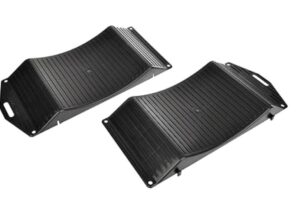Top Tips: How to store your Classic or Supercar for Winter
The Art of Hibernation: Evogo’s Top Tips for Winter Storage of Classic and Supercars
- The Sanctuary: Choosing and Preparing the Storage Environment
The location itself is your first line of defence. For a high value asset, a simple garage may not be enough.
- Climate Control is King: Store the vehicle in a dry, well ventilated, and temperature stable environment. Sudden temperature drops cause condensation, which is the enemy of metal, electrics, and interiors.
- Expert Insight (VCL): For premium facilities, ensure a Vapour Control Layer (VCL) is present beneath the flooring and walls. This is crucial for preventing rising dampness, which severely compromises climate regulation.
- Dehumidification and Airflow: Use a quality dehumidifier or moisture absorbers (silica gel) to maintain relative humidity around 50%.
- Airkaps and Bubbles: If the primary garage environment is not ideal, invest in a dedicated, sealed storage bubble (like a Carcoon or Airkap). These use filtered airflow to create an isolated microclimate, protecting the vehicle from ambient dust and pollutants.
- Security and Insurance: Beyond locks, consider 24/7 monitored CCTV and alarm systems.
- Financial Guardrail: Review your insurance policy. Critically, confirm your policy is an Agreed Value Policy. This is vital to ensure that in the event of total loss while garaged, the payout matches the pre agreed valuation, protecting your investment capital.
- Pest Defence: Block the exhaust pipe and air intakes with steel wool (remember to remove it in spring!) and keep the entire area scrupulously clean to deter nesting rodents.

- Mechanical Mastery: Protecting the Core Systems
An idle engine and system still require meticulous attention to prevent degradation and high cost repairs.
- Fluids and Fuel (The Chemistry)
- Fresh Oil: Change the engine oil and filter before storage. Used oil contains acidic contaminants that can corrode internal engine components over time.
- Full Tank and Stabiliser: Fill the fuel tank to the brim.
- Crucial Tip (Ethanol): For classics with older rubber seals and fuel lines, fill the tank with ethanol free fuel (E5 or performance grade) where possible. Ethanol is hygroscopic (absorbs moisture) and corrosive.
- Action: Add a high quality fuel stabiliser and run the engine for 5 to 10 minutes to circulate the stabilised fuel through the entire system.
- Drivetrain Lubrication: For long term storage (over six months), if possible, perform a very short drive every two months. This keeps the seals and bearings in the gearbox and differential lubricated and prevents oil from pooling and leaving upper parts dry.
- Battery Maintenance (Modern versus Classic)
- The Trickle Charge: Use an intelligent battery conditioner or “trickle charger” designed for long term use. This maintains the optimal charge required by the complex ECUs, immobilisers, and telematics in modern supercars.
- Extreme Storage: For storage exceeding 12 months, particularly in vehicles with multiple parasitic draws, consider removing the battery entirely. Store it in a cool, dry place off the ground and charge it separately once per month.
- Tyres, Brakes, and Suspension
- Preventing ‘Flat Spots’: Over inflate the tyres slightly (e.g., to 50 psi) to counteract pressure loss and distortion. For multi year storage, place the car on axle stands to relieve pressure entirely.
- Tyre Wall Care: Clean the sidewalls with mild soap and water. Avoid petroleum based tyre shines before storage, as these can dry out and crack the rubber over time.
- Handbrake Caution: Never engage the parking brake. The pads/shoes can seize to the discs/drums. Leave the car in gear (or Park) and use wheel chocks to secure the vehicle.
- Complex Suspension Systems: For vehicles with air or hydraulic suspension, refer to the owner’s manual for “storage mode.” Some systems require setting to a specific height (often the highest) or a battery disconnect to prevent unnecessary pump cycling.

- The Details: Bodywork and Interior Preservation
Cosmetics are essential for a car’s valuation and aesthetic integrity.
| Area | Top Tip and Action | Why? |
| Exterior | Thorough Clean and Wax: Wash, dry, and apply two coats of a high quality wax or sealant. Pay attention to wheel arches and door shuts to remove corrosive road salt/brake dust. | Contaminants left on the surface will etch the paint during storage. Protection maintains the finish and value. |
| Finishes | Protect Carbon Fibre and Chrome: Apply a light layer of carnauba wax or a quality ceramic spray to exposed carbon fibre panels and chrome brightwork. | These materials are highly susceptible to moisture etching, fading, and dulling. |
| Interior | Vacuum, Condition and Air: Vacuum, wipe down surfaces, and apply a quality leather conditioner to prevent drying and cracking. Leave the windows cracked a fraction (in a secure, dry facility) to promote airflow. | This deters pests, maintains leather integrity, and prevents musty odours. |
| Intake Guards | Seal Side Intakes: For rear engined cars, cover prominent side air intakes with a fine mesh or cloth after the car has cooled. | This provides an additional layer of defence against insects and nesting rodents entering the airbox. |
| Covering | Use a Breathable Cover: Invest in a high quality, breathable, multi layer car cover designed for indoor use. | Non breathable covers trap moisture, leading to condensation, mould, and paint blistering. |
- The Exit Strategy: A Note on Spring Awakening
When the warm weather returns, resist the urge to immediately hit the road.
- Remove Blockages: Remove all steel wool, chocks, interior absorbers, and intake covers.
- Tyre Check: Reduce the tyre pressures back to the manufacturer’s recommended PSI.
- Pre Start Procedure (Oil Pressure): If stored for over six months, briefly turn the engine over without starting (disable ignition/fuel pump) to build up oil pressure slightly before the first start. This ensures lubrication reaches critical upper components.
- First Start: Connect the fully charged battery. Allow the engine to run until it reaches operating temperature to circulate oil and burn off internal condensation.
- Final Checks: Take a slow drive, testing the brakes gently. Perform a brake fluid level check and look for any soft pedal feel—a sign that seals may be compromised and require a fluid flush.
Evogo Asset Finance: Preserving Value, Enabling Passion
Proper winter storage is not just maintenance; it is a fundamental act of asset preservation. By following this meticulous preparation guide, you ensure your classic or supercar retains its performance, beauty, and, most importantly, its intrinsic and financial value.
Considering leveraging your collection?







